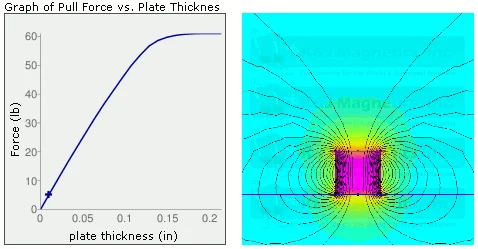Magnetic Pull Force Varies with Steel Plate Thickness
First, let's briefly discuss how we tested for the Pull Force values .When we stick a single magnet to a big, flat, thick steel plate. With a pull force gauge, we measure the force required to pull that magnet directly away from the steel plate.
What is a big, flat, thick steel plate?
Big means it is at least 2 - 3 times bigger than the biggest dimension of the magnet.
Flat means it has been machined to a very flat surface.
Thick means plenty thick enough to ensure that the steel is not saturated -- always at least 1" thick in our test rig.
What happens if you stick a magnet on a very thin plate?
With a thick plate, the steel is not magnetically saturated. It can "hold" all of the magnetic flux coming from the magnet. If you make the plate thicker, say switching from a 1 inch thick plate to a 2 inch thick plate, it won't make the pull force any stronger. When this is the case, you'll see very little magnetic field on the far side of the steel.
If you attach a magnet to a very thin plate, the steel may become magnetically saturated. This means that it can't hold all the magnet's flux, and you don't get 100% of the pull force you would with a thicker plate. When this is the case, you'll see some of the magnetic field behind the steel, because it isn't thick enough to shield it all.
How thin is "too thin?"
For a given sized magnet, there's a thickness at which the steel is saturated. For any steel plate of this thickness or greater, you should see 100% of our listed Pull Force Case 1. If you use a steel plate that's thicker, you shouldn't see any real increase in the pull force.
When you stick the magnet to sheets that are thinner than this critical number, you will see diminished pull strength.
Let us give an example about Lifting Magnet

What about other magnet sizes?
The thickness at which a steel plate is saturated depends on the size and shape of the magnet. We've compiled a huge amount of data from both computer simulations and experimental testing of our magnets with various sheet-metal thicknesses. .
The lifting capacity of lifter
A. The conversion table of the lifting capacity and the thickness of stee
|
Grade |
the thickness of steel plate |
the ratio of load capacity |
||||||
|
mm |
inch |
HCYQ3000 |
HCYQ2000 |
HCYQ1000 |
HCYQ600 |
HCYQ300 |
HCYQ100 |
|
|
T1 |
Up60 |
Up2.36 |
100% |
100% |
100% |
100% |
100% |
100% |
|
T2 |
55 |
2.16 |
95% |
|||||
|
T3 |
50 |
1.97 |
90% |
95% |
||||
|
T4 |
45 |
1.77 |
85% |
90% |
||||
|
T5 |
40 |
1.57 |
80% |
85% |
||||
|
T6 |
35 |
1.38 |
70% |
75% |
90% |
|||
|
T7 |
30 |
1.18 |
60% |
65% |
80% |
|||
|
T8 |
25 |
0.98 |
50% |
55% |
70% |
90% |
||
|
T9 |
20 |
0.79 |
40% |
45% |
60% |
75% |
90% |
|
|
T10 |
15 |
0.59 |
30% |
35% |
50% |
60% |
70% |
|
|
T11 |
10 |
0.39 |
20% |
25% |
35% |
45% |
50% |
70% |
|
T12 |
5 |
0.2 |
10% |
15% |
20% |
25% |
30% |
40% |
b.The conversion table of steel surface roughness(FX),steel material types(MX) and the lifting capacity.
(FX)The steel surface roughness(FX)
F1 1.6μm 125%
F2 6.3μm 100%
F3 12.6μm 90%
F4 25μm 80%
The steel material types(MX)
|
M1 |
Low carbon steel 100% |
|
M2 |
medium carbon steel 95% |
|
M3 |
High carbon steel 85% |
|
M4 |
Low metal alloy steel 75% |
|
M5 |
Cast iron 60% |
If you have any feedback or questions, please email us at info@u-polemag.com. We'd love to hear about how you're using this tool, and any comments you might

